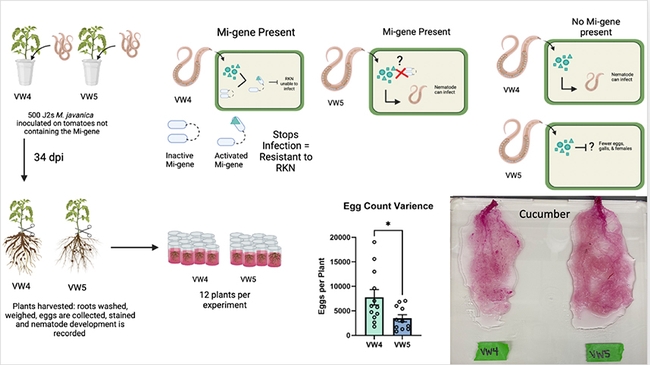
Coomer, who delivered her video presentation on “Trade-Offs Between Virulence and Breaking Resistance in Root-Knot Nematodes,” was selected one of the nine finalists in a global graduate student competition sponsored by the International Federation of Nematologists (IFN). The final round will take place later this month.
Coomer joins only one other graduate student from the United States in the finals: Bhupendra Bhatta of the University of Idaho, Moscow. The others are from universities in England, Australia, Brazil, Ireland, Kenya, Belgium and South Africa.
IFN hosts the competition "to cultivate student academic and research communication skills, and to enhance overall awareness of nematodes and the science of nematology."
The awards will be announced before January 2022. The first-, second-, and third-place winners will be awarded busaries and plaques at the 7th International Congress of Nematology, set May 1-6 in Antibes, France.
For the competition, the participants were required to present only a single static slide, and not use any props or sound-effects. Judges scored them on the quality of their research presentation, ability to communicate research to non-specialists, and the 3MT slide. Each was to use lay language.
In her presentation, Coomer began with: “Root-knot nematodes, specifically the MIG-group, consisting of Meloidogyne incognita, javanica, and arenaria, are the most damaging of the plant parasitic nematodes causing severe yield loss in over 2,000 different plant species including tomatoes. The Mi-gene, which is a resistance gene in tomato, has been used in commercial farming and has been praised for its effectiveness towards the MIG group. This gene has been cloned but the mechanisms of how it's resistance works is still unknown.”
“We do know that with the presence of the MI gene, plants are more durable and will restrict infection and reproduction, by inducing an immune response within the plant,” Coomer pointed. “Although this resistance gene has been reliable for many decades, resistance breaking strains of root-knot nematodes have emerged threatening the tomato industry.”
Coomer related that her research “compares two strains of the root-knot nematode M. javanica. One strain is the wildtype, which has been isolated from fields, we will refer to it as VW4. This nematode can infect tomato plants, but when the MI gene is present, the nematode is blocked from successfully infecting. The other strain is a naturally mutated version of VW4. This strain breaks the resistance provided by the MI gene and therefore infects plants that contain the MI gene. I have labeled this strain as VW5. With the help of research like mine we can stay ahead of the resistance breaking strains and prevent major crop loss in the future.”
“Sequencing the entire genome of VW5 when compared to VW4, we can see that there is a large deletion in its genome, but we have yet to find out what genes were deleted and how important they are when it comes to infecting other plants,” she continued. “My research is focusing on what happens when we infect the resistance breaking strain, VW5 on plants not containing the MI gene.”
In detailing her research, she said “My infection assays have been designed as displayed by the flow chart. Tomato and cucumber were used since neither variety contained the MI gene. 500 J2s were inoculated and at 34 days post inoculation, roots were harvested, and eggs were collected. After staining, galls were dissected, and nematode stage development was recorded for juveniles and females; comparisons between the two roots were made. As displayed by the graph and image, consistently, we see a reduction in the number of eggs produced in plants infected with VW5 than with VW4. The image also shows significant reduction in galls for VW5s as well. Two main objectives remain for this project: How does VW5 break MI resistance and why is VW5 less fit on plants that do not contain the MI gene. With the help of further infection assays and genomic data regarding gene presence and transcription analysis we hope to shed light on this process, identify candidate genes in action, and overall identify how the mechanism of the MI gene works.”
Coomer, a doctoral student in plant pathology with an emphasis on nematology, is working on her dissertation, "Plant Parasitic Nematode Effectors and Their Role in the Plant Defense Immune System," advised by Siddique.
Coomer, originally from the St. Louis, Mo., area, received two bachelor degrees--one in biology and the other in chemistry--in May 2020 from Concordia University, Seward, Neb., where she won the Outstanding Graduate Student in Biology Award. She served as a biology lab assistant and taught courses in general biology and microbiology.
As a biological science aide/intern, Coomer did undergraduate research in the Sorghum Unit of USDA's Agricultural Research Service. Lincoln, Neb. Her work included collecting, prepping and analyzing DNA, RNA and proteins to identify genes that contribute to an under- and over-expression of lignin in sorghum plants.
Attached Images:
